Family Name: Phyllanthaceae Martinov
Synonym(s): Antidesmataceae Loudon; Aporosaceae Lindl. ex Planch.; Bischofiaceae Airy Shaw; Euphorbiaceae Juss., nom. cons. subfam. Phyllanthoideae; Hymenocardiaceae Airy Shaw; Porantheraceae Hurus.; Scepaceae Lindl.; Stilaginaceae C. Agardh; Uapacaceae Airy Shaw
Common Name(s): leafflower family
*Number of genera/species: 57/2,050
List of genera records in GRIN-Global
Fruit usually a capsular schizocarpschizocarp:
usually dry fruit splitting between two or more locules to form distinct, indehiscent, usually one seeded segments; fruit derived from a single, superior or inferior, compound ovary; compare to mericarp splitting, often explosively so, into 3(–5) 2-valved, loculicidalloculicidal:
splitting, often explosively so, into 3(–5) 2-valved, loculicidalloculicidal:
type of capsular dehiscence, opening longitudinally through the locules (compare septicidal)
 mericarps, columellacolumella:
mericarps, columellacolumella:
any pedestal-like prolongation of a floral receptacle extending beyond the distalmost level of perianth insertion and bearing the gynoecium; the stalk supporting a mericarp after dehiscence of a schizocarpic fruit, the central axis of the fruit having split longitudinally to yield two or four such stalks; composed of receptacular and (primarily) gynoecial tissues, especially in Apiaceae. See carpophore.
persistent, sometimes winged, sometimes a drupedrupe:
(indehiscent drupe) a fleshy, indehiscent fruit with one more hard pits enclosing seeds, derived from single, superior, simple or compound ovary; (dehiscent drupe) a fruit with a dry or fibrous to fleshy or leathery outer husk that early to tardily breaks apart (or opens), exposing one or more nutlike pits enclosing the seeds (1–3 pyrenespyrene:
(1–3 pyrenespyrene:
the hard inner portion of a drupe, consisting of a bony endocarp and an enclosed seed
), berryberry:
an indehiscent, fleshy fruit with one or a few to many seeds. The flesh may be homogenous throughout. Or, if the outer part is hard, firm, or leathery, referred to as an hesperidium. Septa are present in some, and the seeds may be arillate or with a fleshy testa. , or samarasamara:
, or samarasamara:
a winged, indehiscent, dry fruit containing a single (rarely two) seed(s) , 0.5–30 mm long, usually globoseglobose:
, 0.5–30 mm long, usually globoseglobose:
3D shape—more or less spherical or oblateoblate:
or oblateoblate:
depressed globose
, 3-lobed, tereteterete:
approximately circular in cross section; width and thickness approximately equal
 in transection, sometimes beakedbeak:
in transection, sometimes beakedbeak:
a usually firm, terminal appendage, sometimes tapered , crowned by persistent sepalssepal:
, crowned by persistent sepalssepal:
a member of the outer envelope of a flower (calyx)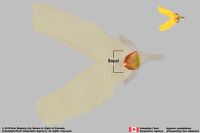 and/or disk. Fruits usually with 2 seeds per loculelocule:
and/or disk. Fruits usually with 2 seeds per loculelocule:
structurally distinct compartment with the fruit
for a total of 6 seeds (3–8) or 1 or 2 seeds per mericarpmericarp:
a one-seeded section (carpel) of a schizocarp, as in Apiaceae fruits (compare schizocarp)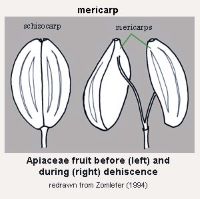 . Pericarppericarp:
. Pericarppericarp:
fruit wall or fruit coat
variously colored, fleshy, leatheryleathery:
texture—moderately thick, tough, and very pliable
, woodywoody:
texture—consisting mainly of indurate lignified tissues, characteristic of or resembling wood
, or cartilaginouscartilaginous:
texture—firm, dense, tough, somewhat pliable, and resilient, like cartilage
, glabrousglabrous:
without hairs
, pubescentpubescent:
surface relief—bearing hairs
, or glandularglandular:
surface relief—covered with small, raised secretory glands, regular or irregularly shaped, translucent or opaque, and maybe distinctly colored , smooth or groovedgrooved:
, smooth or groovedgrooved:
surface relief—linear depressions that may be single or form a series of grooves over the surface , reticulatereticulate:
, reticulatereticulate:
surface relief—netted, raised walls or concave grooves forming a net-like surface pattern with flat, concave, or convex interspaces , veiny, wrinkledwrinkled:
, veiny, wrinkledwrinkled:
surface relief—shallow, irregular folds and furrows covering the surface; appearing overall though crumpled and then spread out , wartywarty:
, wartywarty:
surface relief—distinct, rounded projections that are large relative to the fruit size; tuberculate, verrucose , or papillosepapillate:
, or papillosepapillate:
surface relief—bearing minute, distinct, broad-based projections, tapering to a rounded apex . Exocarpexocarp:
. Exocarpexocarp:
outer layer of fruit wall or pericarp, if divided into layers; note here used synonymously with epicarp often distinct from endocarpendocarp:
often distinct from endocarpendocarp:
the inner layer of the pericarp, if divided into layers , then exocarpexocarp:
, then exocarpexocarp:
outer layer of fruit wall or pericarp, if divided into layers; note here used synonymously with epicarp fleshy and endocarpendocarp:
fleshy and endocarpendocarp:
the inner layer of the pericarp, if divided into layers papery, bonybony:
papery, bonybony:
very hard and rather brittle, like bone
, or fibrousfibrous:
texture -- long, flexible threads, thicker than hairs, that densely cover and obscure the surface . Samaras (Hymenocardia) 2-winged with wings forming a distinct V-shape or encircling fruits.
. Samaras (Hymenocardia) 2-winged with wings forming a distinct V-shape or encircling fruits.
Seeds usually trigonoustrigonous:
3D shape—having three faces that meet at distinct angles; triangular in outline
, tereteterete:
approximately circular in cross section; width and thickness approximately equal
 , compressedcompressed:
, compressedcompressed:
flattened; in grasses, used to denote compression (not necessarily flattened) either laterally or dorsiventrally
, or angledangular:
2D shape—having sides that meet at acute or obtuse angles
in transection, 0.4–16 mm long. Usually without carunclescaruncle:
a localized outgrowth of the seed coat near the hilum of the seed; it functions as an elaiosome , except minute carunclescaruncle:
, except minute carunclescaruncle:
a localized outgrowth of the seed coat near the hilum of the seed; it functions as an elaiosome present in Celianella. ArilsAril:
present in Celianella. ArilsAril:
(broad sense) appendicular structure that wholly or partly envelops a seed and is produced from or a modification of the funicle, raphe, or outer integument; usually fleshy or pulpy, sometimes spongy or tufted-capillate, often brightly colored present in Actephila spp., Aporosa, and Baccaurea, usually thin, fleshy, yellow, orange, red, or white, and surround seeds. SarcotestasSarcotesta:
present in Actephila spp., Aporosa, and Baccaurea, usually thin, fleshy, yellow, orange, red, or white, and surround seeds. SarcotestasSarcotesta:
pulpy or fleshy outer layer of the seed coat, simulates aril sometimes present. Seed coat dark or brightly colored, often shinyshiny:
sometimes present. Seed coat dark or brightly colored, often shinyshiny:
uniformly reflecting a high proportion of incident light at all angles , thin or thick, fleshy or dry, crustaceouscrustaceous:
, thin or thick, fleshy or dry, crustaceouscrustaceous:
texture—thin, dry, indurate, and brittle
, bonybony:
very hard and rather brittle, like bone
, or sometimes woodywoody:
texture—consisting mainly of indurate lignified tissues, characteristic of or resembling wood
, smooth or variously ornamented or sculptured. Hila often larger than punctatepunctate:
surface relief—dotted with pits or with translucent, sunken glands or with colored dots, similar to pitted , submedial or terminal, ellipticelliptic:
, submedial or terminal, ellipticelliptic:
2D shape—oval, oblong-like with the 2 ends narrowing and more or less alike
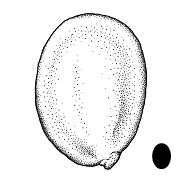 , obtriangularobtriangular:
, obtriangularobtriangular:
2D shape—inversely triangular, with point of attachment at narrow end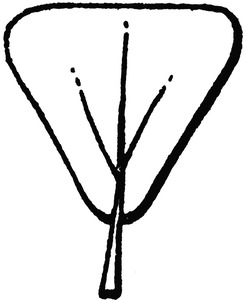 , circularcircular:
, circularcircular:
(of embryo) linear embryo is curved into an "O" shape , oblongoblong:
, oblongoblong:
2D shape—much longer than broad with nearly parallel sides, corners are rounded , or linearlinear:
, or linearlinear:
(shape) long, narrow, and uniform in width; (of embryo) embryo is straight and much longer than wide .
.
Embryo well developed, straight or curvedcurved:
(of embryo) linear embryo is curved into an arch or horseshoe with the ends far apart , sometimes green.
, sometimes green.
Endosperm absent, scanty, or copious, if copious, fleshy.
Can be a weed in uplands, wetlands, grasslands, fields and lawns. Spreads by seed reproduction.
Aquarium & Pond Plants of the World tool includes descriptions and images of Phyllanthus.
| Fruit | |
| Type | capsular schizocarpschizocarp: usually dry fruit splitting between two or more locules to form distinct, indehiscent, usually one seeded segments; fruit derived from a single, superior or inferior, compound ovary; compare to mericarp  , drupedrupe: , drupedrupe:(indehiscent drupe) a fleshy, indehiscent fruit with one more hard pits enclosing seeds, derived from single, superior, simple or compound ovary; (dehiscent drupe) a fruit with a dry or fibrous to fleshy or leathery outer husk that early to tardily breaks apart (or opens), exposing one or more nutlike pits enclosing the seeds  , berryberry: , berryberry:an indehiscent, fleshy fruit with one or a few to many seeds. The flesh may be homogenous throughout. Or, if the outer part is hard, firm, or leathery, referred to as an hesperidium. Septa are present in some, and the seeds may be arillate or with a fleshy testa.  , samarasamara: , samarasamara:a winged, indehiscent, dry fruit containing a single (rarely two) seed(s)  |
| Size range | 0.5–30 mm long |
| Shape(s) | usually globoseglobose: 3D shape—more or less spherical  or oblateoblate: or oblateoblate:depressed globose and 3-lobed, sometimes ellipsoidellipsoid: 3D shape—elliptic , ovoidovoid: 3D shape—ovate  , obovoidobovoid: , obovoidobovoid:3D shape—obovate , trigonoustrigonous: 3D shape—having three faces that meet at distinct angles; triangular in outline , rarely discoiddiscoid: 3D shape—resembling a disc 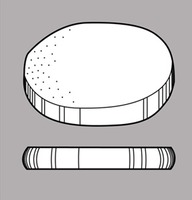 , barrel-shaped, quadrangularquadrangular: , barrel-shaped, quadrangularquadrangular:2D shape—four-sided, as in a square or rectangle 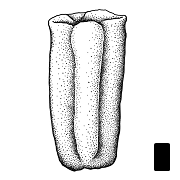 , turbinateturbinate: , turbinateturbinate:3D shape—broadly obovoid-obconic |
| Texture | fleshy, leatheryleathery: texture—moderately thick, tough, and very pliable , woodywoody: texture—consisting mainly of indurate lignified tissues, characteristic of or resembling wood , cartilaginouscartilaginous: texture—firm, dense, tough, somewhat pliable, and resilient, like cartilage |
| Surface relief | smooth, groovedgrooved: surface relief—linear depressions that may be single or form a series of grooves over the surface  , reticulatereticulate: , reticulatereticulate:surface relief—netted, raised walls or concave grooves forming a net-like surface pattern with flat, concave, or convex interspaces  , veiny, wrinkledwrinkled: , veiny, wrinkledwrinkled:surface relief—shallow, irregular folds and furrows covering the surface; appearing overall though crumpled and then spread out  , wartywarty: , wartywarty:surface relief—distinct, rounded projections that are large relative to the fruit size; tuberculate, verrucose  , papillosepapillate: , papillosepapillate:surface relief—bearing minute, distinct, broad-based projections, tapering to a rounded apex  |
| Color(s) | gray, black, purple, green, brown, yellow, orange, red, pink, white, sometimes streaked |
| Unique features | Usually a globoseglobose: 3D shape—more or less spherical  or oblateoblate: or oblateoblate:depressed globose , 3-lobed, capsular schizocarpschizocarp: usually dry fruit splitting between two or more locules to form distinct, indehiscent, usually one seeded segments; fruit derived from a single, superior or inferior, compound ovary; compare to mericarp  splitting, often explosively so, into 3(–5) 2-valved loculicidalloculicidal: splitting, often explosively so, into 3(–5) 2-valved loculicidalloculicidal:type of capsular dehiscence, opening longitudinally through the locules (compare septicidal)  mericarps, with a persistent columellacolumella: mericarps, with a persistent columellacolumella:any pedestal-like prolongation of a floral receptacle extending beyond the distalmost level of perianth insertion and bearing the gynoecium; the stalk supporting a mericarp after dehiscence of a schizocarpic fruit, the central axis of the fruit having split longitudinally to yield two or four such stalks; composed of receptacular and (primarily) gynoecial tissues, especially in Apiaceae. See carpophore. . MericarpsMericarp: a one-seeded section (carpel) of a schizocarp, as in Apiaceae fruits (compare schizocarp)  often 2-seeded. Sometimes a drupedrupe: often 2-seeded. Sometimes a drupedrupe:(indehiscent drupe) a fleshy, indehiscent fruit with one more hard pits enclosing seeds, derived from single, superior, simple or compound ovary; (dehiscent drupe) a fruit with a dry or fibrous to fleshy or leathery outer husk that early to tardily breaks apart (or opens), exposing one or more nutlike pits enclosing the seeds  (1–3 pyrenespyrene: (1–3 pyrenespyrene:the hard inner portion of a drupe, consisting of a bony endocarp and an enclosed seed ), berryberry: an indehiscent, fleshy fruit with one or a few to many seeds. The flesh may be homogenous throughout. Or, if the outer part is hard, firm, or leathery, referred to as an hesperidium. Septa are present in some, and the seeds may be arillate or with a fleshy testa.  , or samarasamara: , or samarasamara:a winged, indehiscent, dry fruit containing a single (rarely two) seed(s)  . . |
| Seed | |
| Size range | 0.4–16 mm long |
| Shape(s) | hemisphericalhemispherical: 2D shape—shaped like half a sphere , globoseglobose: 3D shape—more or less spherical  , orbicularorbicular: , orbicularorbicular:2D shape—circular in outline, 3D shape—globose 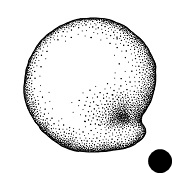 (if flattened), segmentiform, ellipsoidellipsoid: (if flattened), segmentiform, ellipsoidellipsoid:3D shape—elliptic , fusiformfusiform: spindle-shaped; broadest at the middle and tapering at both ends  , ovoidovoid: , ovoidovoid:3D shape—ovate  , reniformreniform: , reniformreniform:2D or 3D shape—kidney-shaped  , trigonoustrigonous: , trigonoustrigonous:3D shape—having three faces that meet at distinct angles; triangular in outline , prismaticprismatic: like a prism; with sharp, definite angles and flat sides , crescent-shapedcrescent-shaped: 2D shape—arcuate or curved, broadest at the middle, and attenuate to acute ends; like a stylized outline of a first-quarter moon 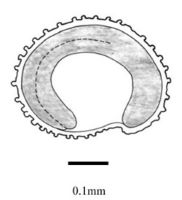 |
| Surface relief | smooth, striatestriate: surface relief—having fine, parallel lines, grooves or ridges  , ridgedridged: , ridgedridged:surface relief—raised, thick ridges, sharp edged or rounded, usually in a series that may cover the entire surface  , ribbedribbed: , ribbedribbed:surface relief—wide, prominent, linear ridges that are generally rounded and longitudinally situated on the surface  , furrowed, granulate, scalariform, blisteredblistered: , furrowed, granulate, scalariform, blisteredblistered:surface relief—covered with irregular raised, hollow granules that give the surface a bubbled appearance 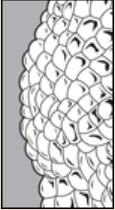 , reticulatereticulate: , reticulatereticulate:surface relief—netted, raised walls or concave grooves forming a net-like surface pattern with flat, concave, or convex interspaces  , papillosepapillate: , papillosepapillate:surface relief—bearing minute, distinct, broad-based projections, tapering to a rounded apex  , pittedpitted: , pittedpitted:surface relief—surface with small depressions in which the areas between the hollows do not take on the appearance of a true reticular net  , wartywarty: , wartywarty:surface relief—distinct, rounded projections that are large relative to the fruit size; tuberculate, verrucose  , wrinkledwrinkled: , wrinkledwrinkled:surface relief—shallow, irregular folds and furrows covering the surface; appearing overall though crumpled and then spread out  , with 1–3 deep circularcircular: , with 1–3 deep circularcircular:(of embryo) linear embryo is curved into an "O" shape  pits pits |
| Color(s) | gray, black, purple, blue, green, brown, red-brown, yellow, orange, red |
| Unique features | Seeds usually trigonoustrigonous: 3D shape—having three faces that meet at distinct angles; triangular in outline without carunclecaruncle: a localized outgrowth of the seed coat near the hilum of the seed; it functions as an elaiosome  , although carunclescaruncle: , although carunclescaruncle:a localized outgrowth of the seed coat near the hilum of the seed; it functions as an elaiosome  or arilsaril: or arilsaril:(broad sense) appendicular structure that wholly or partly envelops a seed and is produced from or a modification of the funicle, raphe, or outer integument; usually fleshy or pulpy, sometimes spongy or tufted-capillate, often brightly colored  present in a few genera, and variously ornamented or sculptured. present in a few genera, and variously ornamented or sculptured. |
| Other | |
| Embryo | well developed, straight or curvedcurved: (of embryo) linear embryo is curved into an arch or horseshoe with the ends far apart  , sometimes green , sometimes green |
| Nutritive tissue | endosperm absent, scanty, or copious, if copious, fleshy |
Tropical regions, especially Malesia
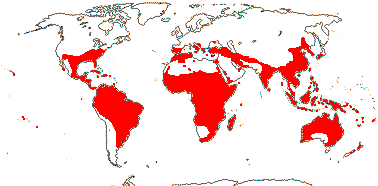
Distribution map courtesy of Angiosperm Phylogeny Website.
Barrett 2012Barrett 2012:
Barrett RL. 2012. Poranthera moorokatta (Phyllanthaceae), a rare new species from Perth, Western Australia. Nuytsia 22: 399–407.; Bingham et al. 2021+Bingham et al. 2021+:
Bingham MG, Willeman A, Wursten BT, Ballings P, and Hyde MA. 2021. Flora of Zambia. Accessed January 2021–April 2024. URL: https://www.zambiaflora.com; Boutman et al. 2022Boutman et al. 2022:
Boutman RW, Kebler PJA, Telford IRH, Bruhl JJ, Strijk JS, Saunders RMK, Esser H-J, Falcón-Hidalgo B, and Van Welzen PC. 2022. A revised phylogenetic classification of tribe Phyllantheae (Phyllanthaceae). Phytotaxa 540: 1–100. https://doi.org/10.11646/phytotaxa.540.1.1; Flora of Australia 2021+Flora of Australia 2021+:
Flora of Australia. Australian Biological Resources Study, Canberra. Accessed January 2021–March 2024. URL: http://www.ausflora.org.au; Halford and Henderson 2005Halford and Henderson 2005:
Halford DA and Henderson RJF. 2005. Studies in Euphorbiaceae s.lat. 6. A revision of the genus Poranthera Rudge (Antidesmeae, Porantherinae) in Australia. Austrobaileya 7: 1–25; Kirkbride et al. 2006Kirkbride et al. 2006:
Kirkbride JH, Jr, Gunn CR, and Dallwitz MJ. 2006. Family guide for fruits and seeds, vers. 1.0. Accessed September 2020-January 2022. URL: https://nt.ars-grin.gov/seedsfruits/keys/frsdfam/index.cfm .; Kubitzki et al. 1990+Kubitzki et al. 1990+:
Kubitzki K et al., eds. 1990+. The families and genera of vascular plants. 7+ vols. Berlin etc.; Low et al. 2014Low et al. 2014:
Low YW, Leong PKF, Tee SP, Singh R, Tay MLC, and Wong KM. 2014. Margaritaria (Phyllanthaceae), a new generic record for the Singapore flora. Gardens' Bulletin Singapore 66: 47–56.; Milliken et al. 2009+Milliken et al. 2009+:
Milliken W, Klitgard B, and Baracat A. 2009+. Neotropikey - Interactive key and information resources for flowering plants of the Neotropics.; Silva and Ferreira de Sales 2017Silva and Ferreira de Sales 2017:
Silva M J and M Ferreira de Sales. 2017. Phyllanthus L. (Phyllanthaceae) em Pernambuco, Brasil. Acta Botanica Brasilica 21(1): 79–98.; Tagane et al. 2015Tagane et al. 2015:
Tagane S, Dang VS, Toyama H, Naiki A, Nagamasu H, Yahara T, and Tran H. 2015. Aporosa tetragona Tagane & V. S. Dang (Phyllanthaceae), a new species from Mt. Hon Ba, Vietnam. PhytoKeys 57: 51–60. https://doi.org/10.3897/phytokeys.57.6347; Takhtajan 2009Takhtajan 2009:
Takhtajan A. 2009. Flowering plants: Second edition. Springer Nature, Switzerland. 871 pp.; Zhengyi et al. 2004+Zhengyi et al. 2004+:
Zhengyi W, Raven PH, and Deyuan H. 2004+. Flora of China [online]. 25 vols. Science Press, Beijing China & Missouri Botanical Garden, St. Louis USA. Accessed January–March 2024. http://flora.huh.harvard.edu/china/
*The number of genera and species is based on Christenhusz and Byng 2016Christenhusz and Byng 2016:
Christenhusz MJM and Byng JW. 2016. The number of known plant species in the world and its annual increase. Phytotaxa 261 (3): 201-217. https://doi.org/10.11646/phytotaxa.261.3.1, which may differ from the number of genera in GRIN-Global.